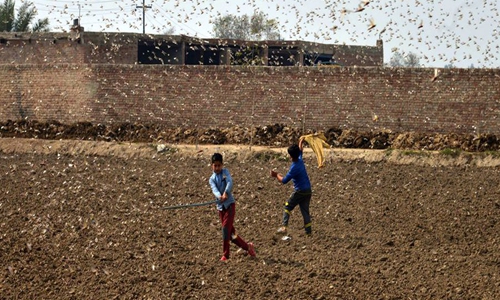HOME >> CHINA
Eaten by ducks, fried for food: Locusts not a threat to China
By Liu Xin and Shan Jie Source:Global Times Published: 2020/2/17 18:53:40

Photo taken with mobile phone on Feb. 15, 2020 shows Pakistani children trying to avoid locusts swarming in Okara district in eastern Pakistan's Punjab province. (Str/Xinhua)
Growing worries are surfacing that a large-scale locust outbreak may occur in China's border regions, including Northwest China's Xinjiang Uygur Autonomous Region, said experts.Chinese authorities and local residents in these areas said China have gained a lot of experience in locust prevention and there is little chance of a locust plague expanding in China.
The Food and Agriculture Organization of the United Nations (FAO) issued a warning on the locust plague, which started in Africa and now reached Pakistan and India, prompting concerns by some Chinese netizens.
A resident surnamed Wang from Xinjiang told the Global Times that previous locust outbreaks happened in the end of summer and autumn in the region's grassland areas. But winter temperatures and a lack of grass in the region inhibit locusts.
Wang noted that a division of the Xinjiang Production and Construction Corps in Hami used to prevent the locust outbreak by raising ducks and chickens.
Due to the dry weather, locusts plagued around 100,000 mu of farmland of the division in June 2018. The farmland released 1,000 ducks to eat the locusts.
One duckling can "control" a 4-square-meter of land and eat the locusts. Using ducks to prevent locust plague is economically and environmentally friendly compared with spraying pesticides, according to Wang.
Some netizens also worried that Southwest China's Yunnan Province and Tibet Autonomous Region are vulnerable to locust plagues. Residents and experts in Yunnan reached by the Global Times said Yunnan has many mountainous areas and locusts do not like moist and cold environment. But Xishuangbanna Dai Autonomous Prefecture in Yunnan was plagued by locusts from Laos in 2018.
The way to prevent a locust plague in Xinjiang is one example as China, as a country that used to be plagued by locusts, has gained more experience in prevention of such disasters, experts said.
In the summer of 2017, a locust plague happened in East China's Shandong Province, which affected local agricultural production.
However, as fried locust is a tradition dish in local cuisine, some farmers turned to catching locusts to sell. "Our corn harvest would be reduced for sure, but catching locusts brought me a lot more money," said a villager quoted by The Beijing News.
Locusts are on restaurant menus in many regions in China. Fresh or frozen locusts are priced from 17 ($2.43) to 400 yuan per kilogram depending on different species and characteristics.
The locusts are cultivated by farms in Shandong, Southwest China's Yunnan Province and Northeast China's Jilin Province.
Some online memes, when mentioning the 2017 plague, said the "locust plague was eaten up in China."
However, media reports showed that in 2017, Shandong used helicopters and drones to prevent and control the plague. Agricultural production in some regions was reduced 20 to 30 percent.
China has frequently suffered from locust plague. According to documents, a plague happened every 8.8 years on average in the Qin (221 BC-206 BC) and Han (206 BC-AD 25) dynasties. In the Yuan Dynasty (1279-1368), locust plagues came as frequent as every 1.6 years.
Before 1949, in the previous 2,600 years of history, 800 locust plagues were recorded, mainly affecting the plain agricultural regions along the Yellow River and the Huaihe River in eastern China, read an article by Chen Yonglin, an entomologist at the Institute of Zoology, Chinese Academy of Sciences (CAS).
In 1950s, combating locust plagues became a significant task for China, with the aim to eliminate them. After researching Asian migratory locusts' habits, in 1950s and 1960s, China not only used pesticides, but trimmed waterways to prevent the reproduction of locusts, according to the article.
"The locust plague management is very successful in China," said Kang Le, a locust expert at CAS's Institute of Zoology, the China Science Daily reported on Saturday.
In 2014, Kang and his team uncovered the genome of locusts. Now they are studying to contain locust plagues with genetic means. For instance, they have completed genetically modifying Metarhizium anisopliae, a powerful pesticide. The team has also finished editing genes of locusts, according to the report.
Kang said that they have contacted science institutes and governments in Africa for cooperation.